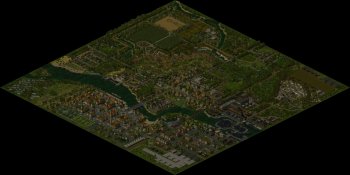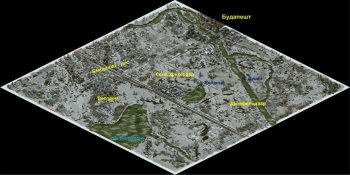(RWG ToW 0.4) Mаас
MAAS
Map: 384*384
Player: Germany
Opponent: France
Map: -IG-
Mission: -IG-
Changes compared to the version under RWG 1.91:
-completely removed timers and reworked mission logic. Now there is no reference to time (timers and alarms);
-completely redesigned map with the addition of new buildings, objects, etc.;
-Completely redesigned reinforcements. Units added and replaced with historically more reliable ones;
The mission is strictly based on historical facts (as far as it is possible to implement this in terms of playability and our own modest capabilities).
May 12, 1940, Belgium
Under your command are units of the 4th Wehrmacht Army, the 5th and 7th Panzer Divisions, which have reached the Meuse through the Ardennes.
Your goal is to cross the river. Meuse in the area of the city of Dinan, expansion and retention of the bridgehead and further offensive in a westerly direction.
“Near the town of Houx, the Germans discovered a dam and by 23.00 on May 12, the forces of the reconnaissance battalion company of the 5th tank seized a small bridgehead on the western bank. The dam itself was not blown up for fear that the water level upstream would decrease and this would allow fording the river.
On the French side. It was assumed that the defense along the river would be occupied by units of the 18th French infantry division, but not all of its units had time to approach the river, and therefore, it was decided to fill the gap with a battalion from the 39th regiment of the 5th motorized division. The battalion itself approached the river when the Germans were already on the east bank. On the morning and afternoon of May 13, the Germans expanded the bridgehead with 3 infantry battalions of the 5th Panzer Division, as well as a motorcycle battalion of the 7th Division. The French counterattack on this bridgehead with the forces of one battalion of the 129th regiment, scheduled for 13.00 on May 13, began only at 14.00 and was thwarted by German aircraft. On the evening of May 13, the French again launched an attack, now with tanks, which, however, were not supported by the infantry, and therefore the tanks returned. In the area directly to Dinan, on the night of 12/13, the Germans were able to move to the other side near an infantry company. At dawn, the French fire intensified and the commander of the 7th Panzer Division (Rommel) ordered to set fire to several houses in order to create a smoke screen. Also, tanks and artillery were sent to the crossing point in order to suppress the defenders. After that, the Germans began to cross again on boats and pontoons. Under cover of fire, the Germans were able to transport two more infantry companies. Rommel also crossed over to the other side and for some time he himself commanded the crossing companies. At this time, the Germans were counterattacked by French tanks (elsewhere by armored cars). The counterattack was repulsed by the Germans. After that, Rommel crossed to the east bank of the river and headed for the town of Houx, where sappers were building an 8-ton pontoon bridge. Since such a bridge could not withstand the German threes and fours, Rommel ordered a 16-ton bridge to be built instead of an 8-ton one. By dawn on the 14th, the Germans were able to transport 15 tanks to the west coast, which came in very handy, as the French launched another counterattack on the bridgehead. The French this time acted in concert and even drove the Germans out of the town of Haut-le-Wastia. With the help of tanks and aircraft, this French counterattack was also repulsed. Then on May 14, having accumulated strength, the Germans launched an offensive.
"Meanwhile, not only the cavalry corps is fighting in Belgium, but the 1st tank division of the reserve - 1 DCR. It participates in the battle for Flavion. This battle was an example of a clash of two concepts for the use of tank troops - French and German. In the battle of Flavion, the French 1 DCR collided with the German 5. PzD and 7. PzD (tank divisions).
At that time, 1 DCR had 144 tanks, including 62 heavy B1bis. The rest of the vehicles are Hotchkiss H39 light tanks. Also, the division consisted of 9 25 mm anti-tank guns, 8 47 mm anti-tank guns, 6 25 mm anti-aircraft guns. Tanks and artillery were supported by an infantry battalion.
The battles unfolded on May 15. Moreover, the 1st division was also supported by the tanks of the 6th separate tank battalion - 12 Renault R35. However, many French tank columns were defeated by German aircraft. As a result, many tanks had fuel for 1-2 hours of travel.
The two German divisions had a total of 546 tanks. 5. The PzD had 243 light vehicles Pz I and Pz II, 84 medium Pz III/IV. 7. PzD - 109 Pz I and II, 110 Pz 38(t) and IV.
The first to enter the battle are the forces of the 25th Panzer Regiment 7. PzD and 28 BCC 1 DCR, however, the commander of the German division, General Erwin Rommel, avoids a direct collision of his tanks with heavy French vehicles. The "eight-eight" come to the fore - heavy 88 mm anti-aircraft guns, large-caliber field artillery, which block any advance of French armored vehicles. At the same time, unlike the French, the Germans have air support - this forces the French infantry to stay in the rear.
Of the 144 French tanks, only 62 B1s would meet the first attack of two German panzer divisions. They will have to face more than 300 German vehicles.
The Germans began their offensive at 8 am on May 15. Already by 8-30 the parties entered into a military clash. The French were able to oppose only 26 B1 to 219 German tanks. In the very first minutes of the battle, the Germans lost 5 tanks. French tanks were practically invulnerable to German guns, usually 20 and 37 mm. Opponent tanks are located at a distance of no more than 100 meters from each other. “One French tank is finally knocked out and on fire,” recalls one of the 7 PzD veterans, “but many more of ours are on fire. We are retreating.”
German commanders quickly realize that Pz II tanks are completely useless against B-series heavy vehicles, and medium tanks are effective against them only from short distances. Aviation and 88 mm anti-aircraft guns come to the rescue. However, the outcome of the battles was decided only by the evening of May 15, and thanks to the personal heroism of individual German tankers. So, one of the German regiments had only one Pz IV tank, capable of withstanding the heavy French "land battleships".
By the beginning of the withdrawal from the battle area, the French were missing 65 tanks. 79 remained operational. Another 10 cars were under repair. German losses in tanks did not exceed the French. From 30 to 60 tanks were irretrievably lost. The total losses were (destroyed and lined) by the Wehrmacht in Flavion - up to 100 tanks.


